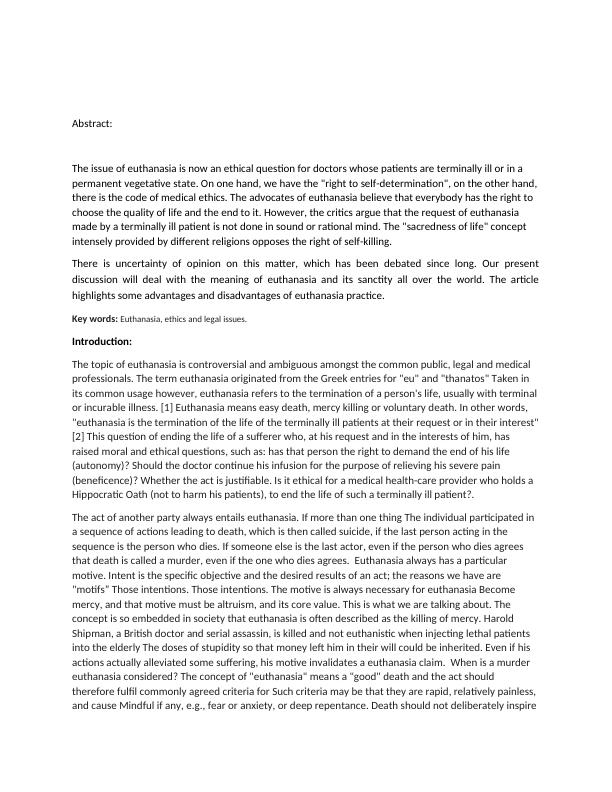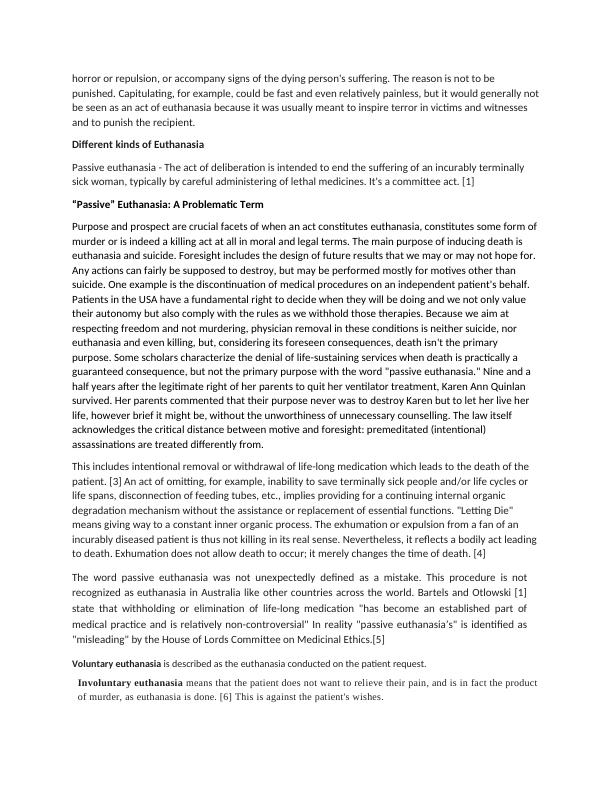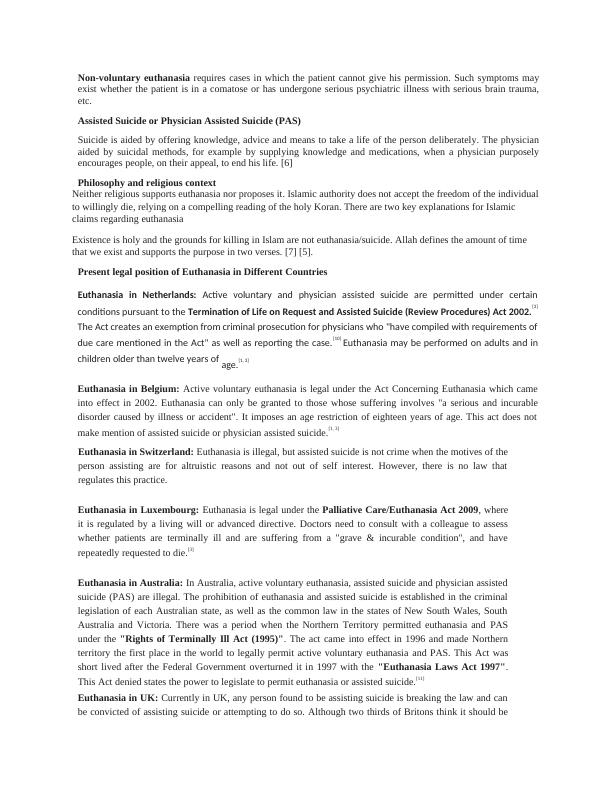Ask a question from expert
(PDF) The basis of right to Self determination
6 Pages3740 Words86 Views
Added on 2021-03-15
(PDF) The basis of right to Self determination
Added on 2021-03-15
BookmarkShareRelated Documents
Abstract:The issue of euthanasia is now an ethical question for doctors whose patients are terminally ill or in a permanent vegetative state. On one hand, we have the "right to self-determination", on the other hand,there is the code of medical ethics. The advocates of euthanasia believe that everybody has the right to choose the quality of life and the end to it. However, the critics argue that the request of euthanasia made by a terminally ill patient is not done in sound or rational mind. The "sacredness of life" concept intensely provided by different religions opposes the right of self-killing.There is uncertainty of opinion on this matter, which has been debated since long. Our presentdiscussion will deal with the meaning of euthanasia and its sanctity all over the world. The articlehighlights some advantages and disadvantages of euthanasia practice.Key words: Euthanasia, ethics and legal issues.Introduction:The topic of euthanasia is controversial and ambiguous amongst the common public, legal and medical professionals. The term euthanasia originated from the Greek entries for "eu" and "thanatos" Taken in its common usage however, euthanasia refers to the termination of a person's life, usually with terminalor incurable illness. [1] Euthanasia means easy death, mercy killing or voluntary death. In other words, "euthanasia is the termination of the life of the terminally ill patients at their request or in their interest"[2] This question of ending the life of a sufferer who, at his request and in the interests of him, has raised moral and ethical questions, such as: has that person the right to demand the end of his life (autonomy)? Should the doctor continue his infusion for the purpose of relieving his severe pain (beneficence)? Whether the act is justifiable. Is it ethical for a medical health-care provider who holds a Hippocratic Oath (not to harm his patients), to end the life of such a terminally ill patient?.The act of another party always entails euthanasia. If more than one thing The individual participated in a sequence of actions leading to death, which is then called suicide, if the last person acting in the sequence is the person who dies. If someone else is the last actor, even if the person who dies agrees that death is called a murder, even if the one who dies agrees. Euthanasia always has a particular motive. Intent is the specific objective and the desired results of an act; the reasons we have are "motifs” Those intentions. Those intentions. The motive is always necessary for euthanasia Become mercy, and that motive must be altruism, and its core value. This is what we are talking about. The concept is so embedded in society that euthanasia is often described as the killing of mercy. Harold Shipman, a British doctor and serial assassin, is killed and not euthanistic when injecting lethal patients into the elderly The doses of stupidity so that money left him in their will could be inherited. Even if his actions actually alleviated some suffering, his motive invalidates a euthanasia claim. When is a murder euthanasia considered? The concept of "euthanasia" means a "good" death and the act should therefore fulfil commonly agreed criteria for Such criteria may be that they are rapid, relatively painless, and cause Mindful if any, e.g., fear or anxiety, or deep repentance. Death should not deliberately inspire

horror or repulsion, or accompany signs of the dying person's suffering. The reason is not to be punished. Capitulating, for example, could be fast and even relatively painless, but it would generally notbe seen as an act of euthanasia because it was usually meant to inspire terror in victims and witnesses and to punish the recipient.Different kinds of EuthanasiaPassive euthanasia - The act of deliberation is intended to end the suffering of an incurably terminally sick woman, typically by careful administering of lethal medicines. It's a committee act. [1]“Passive” Euthanasia: A Problematic TermPurpose and prospect are crucial facets of when an act constitutes euthanasia, constitutes some form ofmurder or is indeed a killing act at all in moral and legal terms. The main purpose of inducing death is euthanasia and suicide. Foresight includes the design of future results that we may or may not hope for. Any actions can fairly be supposed to destroy, but may be performed mostly for motives other than suicide. One example is the discontinuation of medical procedures on an independent patient's behalf. Patients in the USA have a fundamental right to decide when they will be doing and we not only value their autonomy but also comply with the rules as we withhold those therapies. Because we aim at respecting freedom and not murdering, physician removal in these conditions is neither suicide, nor euthanasia and even killing, but, considering its foreseen consequences, death isn't the primary purpose. Some scholarscharacterizethe denial of life-sustaining services when death is practically a guaranteed consequence, but not the primary purpose with the word "passive euthanasia." Nine and a half years after the legitimate right of her parents to quit her ventilator treatment, Karen Ann Quinlan survived. Her parents commented that their purpose never was to destroy Karen but to let her live her life, however brief it might be, without the unworthiness of unnecessary counselling. The law itself acknowledges the critical distance between motive and foresight: premeditated (intentional) assassinations are treated differently from. This includes intentional removal or withdrawal of life-long medication which leads to the death of the patient. [3] An act of omitting, for example, inability to save terminally sick people and/or life cycles or life spans, disconnection of feeding tubes, etc., implies providing for a continuing internal organic degradation mechanism without the assistance or replacement of essential functions. "Letting Die" means giving way to a constant inner organic process. The exhumation or expulsion from a fan of an incurably diseased patient is thus not killing in its real sense. Nevertheless, it reflects a bodily act leading to death. Exhumation does not allow death to occur; it merely changes the time of death. [4]The word passive euthanasia was not unexpectedly defined as a mistake. This procedure is notrecognized as euthanasia in Australia like other countries across the world. Bartels and Otlowski [1]state that withholding or elimination of life-long medication "has become an established part ofmedical practice and is relatively non-controversial" In reality "passive euthanasia’s" is identified as"misleading" by the House of Lords Committee on Medicinal Ethics.[5]Voluntary euthanasia is described as theeuthanasia conducted on thepatient request.Involuntary euthanasia means that the patient does not want to relieve their pain, and is in fact the productof murder, as euthanasia is done. [6] This is against the patient's wishes.

Non-voluntary euthanasia requires cases in which the patient cannot give his permission. Such symptoms mayexist whether the patient is in a comatose or has undergone serious psychiatric illness with serious brain trauma,etc.Assisted Suicide or Physician Assisted Suicide (PAS)Suicide is aided by offering knowledge, advice and means to take a life of the person deliberately. The physicianaided by suicidal methods, for example by supplying knowledge and medications, when a physician purposelyencourages people, on their appeal, to end his life. [6]Philosophy and religious contextNeither religious supports euthanasia nor proposes it. Islamic authority does not accept the freedom of the individualto willingly die, relying on a compelling reading of the holy Koran. There are two key explanations for Islamic claims regarding euthanasia Existence is holy and the grounds for killing in Islam are not euthanasia/suicide. Allah defines the amount of time that we exist and supports the purpose in two verses. [7] [5].PresentlegalpositionofEuthanasiainDifferentCountriesEuthanasia in Netherlands: Active voluntary and physician assisted suicide are permitted under certainconditions pursuanttotheTerminationofLifeonRequestandAssisted Suicide (Review Procedures) Act 2002.[3]The Act creates an exemption from criminal prosecution for physicians who "have compiled with requirements ofdue care mentioned in the Act" as well as reporting the case.[10] Euthanasia may be performedonadultsandinchildrenolderthantwelveyearsof age.[1,3]Euthanasia in Belgium: Active voluntary euthanasia is legal under the Act Concerning Euthanasia which cameinto effect in 2002. Euthanasia can only be granted to those whose sufferinginvolves"aseriousandincurabledisordercausedby illness or accident". It imposes an age restriction of eighteen years of age. This act does notmake mention of assisted suicideorphysicianassistedsuicide.[1,3]Euthanasia in Switzerland: Euthanasia is illegal, but assisted suicide is not crime when the motives of theperson assisting are for altruistic reasons and not out of self interest. However, there is no law thatregulates this practice.Euthanasia in Luxembourg: Euthanasia is legal under the Palliative Care/Euthanasia Act 2009, whereit is regulated byalivingwilloradvanceddirective.Doctorsneedtoconsult with a colleague to assesswhether patients are terminally ill and are suffering from a "grave & incurable condition", and haverepeatedlyrequestedtodie.[3]Euthanasia in Australia: In Australia, active voluntary euthanasia, assisted suicide and physician assistedsuicide (PAS) are illegal. The prohibition of euthanasia and assisted suicide is established in the criminallegislation of each Australian state, as well as the common law in the states of New South Wales, SouthAustralia and Victoria. There was a period when the Northern Territory permitted euthanasia and PASunderthe"RightsofTerminallyIllAct(1995)".Theact came into effect in 1996 and made Northernterritory the first place in the world to legally permit active voluntary euthanasiaandPAS.ThisActwasshortlivedaftertheFederal Government overturned it in 1997 with the "Euthanasia LawsAct1997".ThisActdeniedstatesthepowertolegislate topermiteuthanasiaorassistedsuicide.[11]Euthanasia in UK: Currently in UK, any person found to be assisting suicide is breaking the law and canbe convicted of assistingsuicideorattemptingtodoso.Althoughtwothirdsof Britonsthinkitshouldbe

End of preview
Want to access all the pages? Upload your documents or become a member.
Related Documents
Right to Determine the Place and Time of Deathlg...
|10
|2959
|222
Ethical Issues Presentation: Mercy Killinglg...
|10
|777
|79
Euthanasia: Law, Ethics, and Controversieslg...
|8
|2757
|50
Euthanasia: Arguments for and Againstlg...
|7
|2844
|82
Benefits of Euthanasialg...
|14
|3124
|167
Benefits of Euthanasia: A Debate on Mercy Killinglg...
|10
|2413
|304